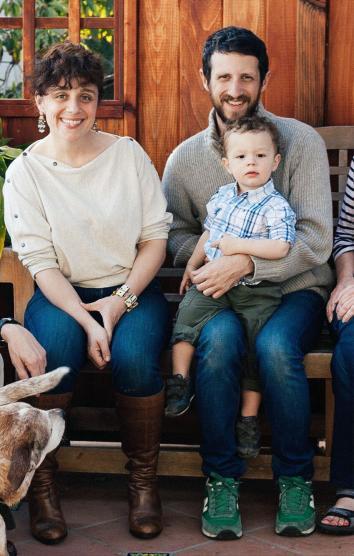Morgan Faust startles awake at 3 a.m., awoken by a rustling in the kitchen of her Los Angeles house. Jack, who was safe in her womb only days ago, begins to wail. In one arm Morgan coddles her crying bundle of joy and in the other a baseball bat. It’s a standoff between Morgan, Jack, and what she soon realizes is a family of raccoons. In rushes Max—Morgan’s raccoon-fighting partner in crime.
Max Isaacson is not Morgan’s husband, boyfriend, or romantic partner—he is her brother, and she is his roommate.
At age 36, Morgan’s career as a TV writer and her social network were thriving, but she kept thinking, “I want to be a parent.” There were no worthy romantic partners on her horizon, but that didn’t stop her from exploring all options. She went to a popular sperm bank in Los Angeles and found her dream donor—great medical records, a parent himself, and a history buff (like her). She was lucky to conceive Jack on her second try with intrauterine insemination.
Morgan and Max were roommates before Jack came along, and this arrangement helped influence her decision to have a child on her own. She invited a team of people into the process even before Jack was conceived—her parents, her best friend (whom she refers to as her “birthing partner”), her doula, and her brother—to create a support system to get her through the almost certain difficulties of being a single mother.
In many ways, Max is involved in Jack’s life like a parent. When Jack was a newborn, Max was able to support Morgan with caregiving responsibilities on a very regular basis. His freelance schedule allowed him more flexibility, and he says that Morgan’s recovery was “no joke.” Morgan sees tremendous value in his role. “Having someone like your brother be there living and sharing the house with you is so vital,” she says, “especially for the little things—like running to grab milk.”

Wes Ocean Bent
To many on the outside, however, Max’s role is perplexing. People frequently asked, “Do you actually change diapers!?” As though, he says, “it was some kind of holy ritual relegated only to those who had spawned the child.” Both Morgan and Max prioritize Jack having a broader community in his life. As Morgan sees it, “I love that Jack can form relationships with all kinds of different people.”
The U.S. Census Bureau defines a “single parent/family household” as a household in which only one parent is present in the home, so it’s hard to track just how many people qualify as single parents but actually have another adult in the home parenting with them. Contrary to what this definition implies, most single parents aren’t actually raising their children alone. A new study from Family Story and Lake Research Partners shows that most single mothers rely on other adults for help raising their kids, and not just financial help. While there are many who parent with minimal support networks, the challenges of doing so with our broken and extremely expensive child care system can be overwhelming. That’s why many single parents are creating nontraditional support systems that function more as family units than as a person parenting “alone.”
As Nicole Rodgers, the co-director and founder of Family Story, a communications organization, says, “Our vocabulary for talking about families is limited. It doesn’t capture the complexities of today’s families.” Those complexities include Morgan, Max, and Jack’s relationship and a whole host of other ties Morgan intentionally built when she decided to have a baby. “The networks around [single parents] are often invisible. We’re doing a disservice to all the people who help them parent when we fail to recognize their contributions,” said Rodgers.
Christina LeBeau is a single mother raising her two kids in small-town Pennsylvania with her friend Terri Fyock. Christina’s daughter, Scarlett, was born early at 27 weeks and diagnosed with autism at age 3. The diagnosis was a huge blow to Christina, who at the time was making ends meet by running in-home child care services to be able to stay home caring for her daughter. Given the diagnosis and the birth of her son, Declan, which shortly followed, she says there was no possible way she would have been able to work outside of the house and afford caregiving. Neither of the children’s fathers are involved in raising the children. These first few years were difficult and isolating for Christina.
When Declan turned 3, she set out to “get a life.” That’s also when she found roller derby and a crew of sisters, including Terri. They became quick friends and then roommates. Terri’s move-in enabled Christina to take a new job working with Head Start, an opportunity she would have never considered before.
“It was a life changer,” she says. “I’ve never had anybody to lean on, pitch in with the kids, to back me up. I generally go through seven babysitters in a summer, and this is the first summer I’ve enjoyed in years.” Terri helps care for the kids when they get sick or during snow days; she’s formed relationships with their teachers and doctors. And what’s more? She’s chief lawnmower and dishwasher.
Many friends have helped Christina along the way, but she believes that Terri is a true gift. “It’s nice to have someone that is woven into the fabric that makes up our home and family, rather than having to reach out to a friend,” Christina said.
Morgan and Christina are not alone in raising their children in non-nuclear households or with people other than a romantic partner. Declining marriage rates coupled with rising numbers of cohabiting relationships (living with an unmarried partner), which increased 29 percent between 2007 and 2016, show that people are shying away from traditional family structures. Attitudes are changing a lot as well. The Family Story survey found a solid majority of unmarried mothers say they would consider raising a child with someone “who is not a spouse or romantic partner.” While respondents agree that one adult can do just as good a job as two, they also believe that children do best with multiple adults, parent or otherwise, invested in their well-being. Many single parents, by choice or not, aren’t parenting all that differently than married parents; they’ve just built different support networks.
Rodgers believes recognizing these approaches to parenting as valid, and as an ongoing reality for many, is key to moving family policy researchers away from a fixation on marriage as the solution to poverty and to child care. “There is a dangerous notion, popular among conservatives, that more marriage is the solution to poverty. It’s used to blame low-income unmarried moms, especially black moms, for the hardships they face, rather than indict the structural forces that allow so much of the country to live with constant economic uncertainty and instability. That’s the real issue,” said Rodgers. Family policy will be more inclusive, and realistic, when researchers accept that marriage does not address the wants and needs of every American family.
The English language currently lacks the words to accurately describe Morgan and Christina’s families. But, by making these increasingly common arrangements more visible, it may help inject some creativity in how politicians, public policy experts, and the public think about these relationships and how crucial they are in successfully raising kids.
